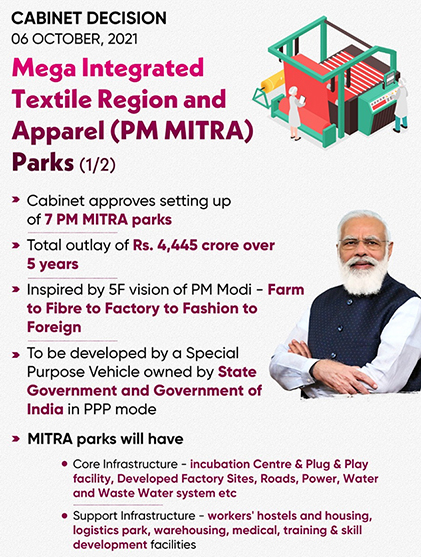Indian Economy
PM MITRA Parks
- 03 Dec 2021
- 5 min read
Why in News
Recently, the Government has approved setting up of 7 PM Mega Integrated Textile Region and Apparel (PM MITRA) Parks in Greenfield/Brownfield sites with an outlay of Rs. 4445 cr for a period of seven years upto 2027-28.
- Government of India is implementing the Scheme for Integrated Textile Park (SITP) which provides support for creation of world-class infrastructure facilities for setting up of textile units.
Key Points
- About:
- It park will be developed by a Special Purpose Vehicle which will be owned by the Central and State Government and in a Public Private Partnership (PPP) Mode.
- Each Park will have an incubation centre, common processing house and a common effluent treatment plant and other textile related facilities such as design centres and testing centres.
- Incubation centre is the institution that assists entrepreneurs in developing their business and solving problems associated with it, especially in the initial stages, by providing an array of business and technical services, initial seed funds, lab facilities, advisory, network and linkages.
- The Master Developer will not only develop the Industrial Park but also maintain it during the concession period.
- Funding:
- The centre will provide development capital support for the development of common infrastructure of Rs 500 crore for each greenfield MITRA park and upto Rs 200 crore for each brownfield park.
- Greenfield describes a completely new project that has to be executed from scratch, while a brownfield project is one that has been worked on by others.
- The centre will provide development capital support for the development of common infrastructure of Rs 500 crore for each greenfield MITRA park and upto Rs 200 crore for each brownfield park.
- Eligibility for Incentives:
- An additional Rs 300 crore will be provided as Competitiveness Incentive Support for the early establishment of textiles manufacturing units in each of these parks.
- Investors who set up “anchor plants” that employ at least 100 people will be eligible for incentives of upto Rs 10 crore every year for upto three years.
- Significance:
- Reduce Logistics Cost:
- It will reduce logistics cost and strengthen the value chain of the textile sector to make it globally competitive.
- High logistics costs are considered a key hurdle to India’s goal of boosting textile exports.
- Employment Generation:
- Each park is expected to directly generate 1 lakh jobs and indirectly generate a further 2 lakh jobs.
- Attract FDI:
- The parks are crucial to attract Foreign Direct Investment (FDI).
- From April 2000 to September 2020, India’s textile sector received Rs 20,468.62 crore of FDI, which is just 0.69% of the total FDI inflows during the period.
- Reduce Logistics Cost:
- Other Related Initiatives:
- The Production Linked Incentive Scheme for man-made fibre segment (MMF) apparel, MMF fabrics and ten products of technical textiles for five years has been approved.
- A National Technical Textiles Mission has already been launched to promote research and development in that sector.
India’s Textile Sector
- About:
- It is one of the oldest industries in the Indian economy, and is a storehouse and carrier of traditional skills, heritage and culture.
- It contributes 2.3% to Indian Gross Domestic Product, 7% of Industrial Output, 12% to the export earnings of India and employs more than 21% of total employment.
- India is the 6th largest producer of Technical Textiles with 6% Global Share, largest producer of cotton & jute in the world.
- Technical textiles are functional fabrics that have applications across various industries including automobiles, civil engineering and construction, agriculture, healthcare, industrial safety, personal protection etc.
- India is also the second largest producer of silk in the world and 95% of the world’s hand woven fabric comes from India.
- Major Initiatives:
- Amended Technology Upgradation Fund Scheme (ATUFS)
- Scheme for Integrated Textile Parks (SITP)
- SAMARTH Scheme.
- North East Region Textile Promotion Scheme (NERTPS)
- Power-Tex India
- Silk Samagra Scheme
- Jute ICARE





